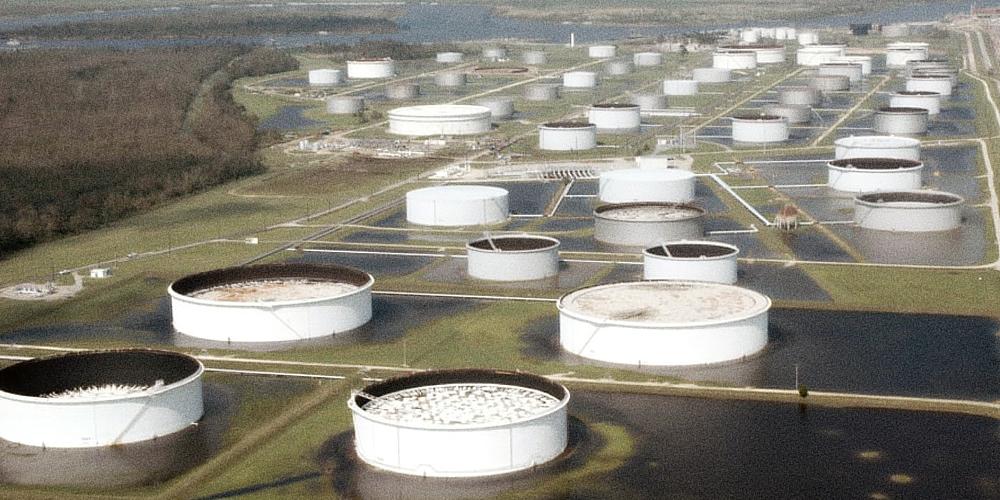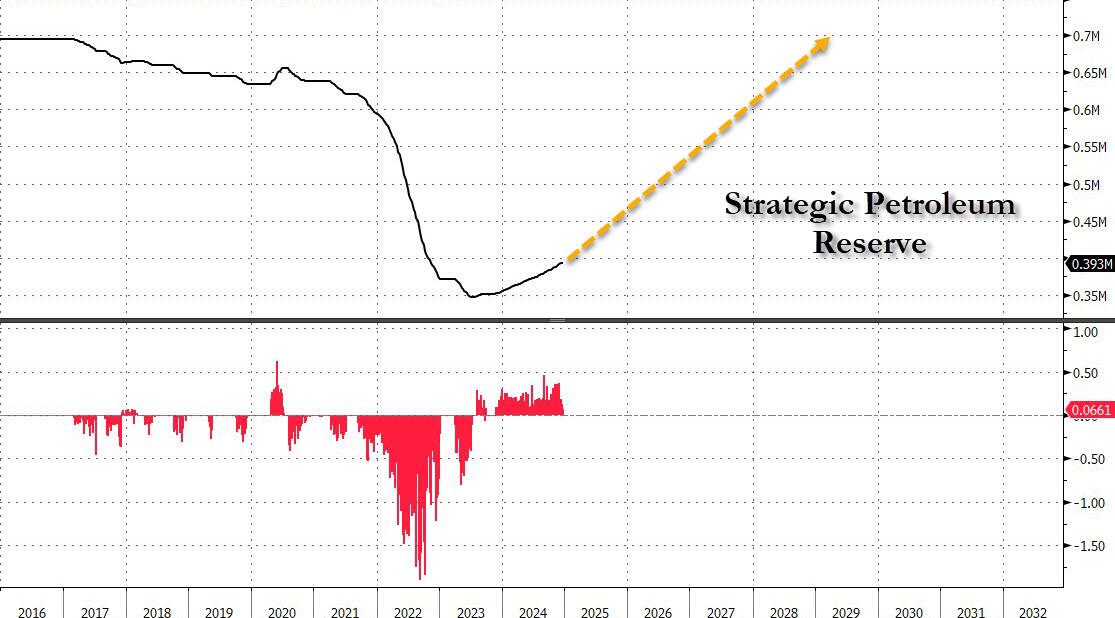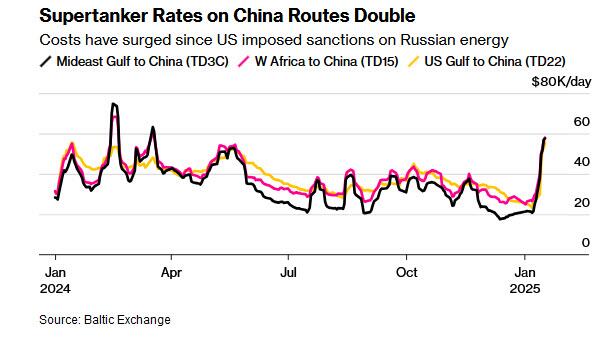(Zero Hedge)—For much of the past year, oil traders were desperate to find a bullish thesis. Now, in the span of just a few weeks, they have two.
On one hand, amid mounting fears of a supply and inventory glut, Biden’s parting gift of accelerated sanctions against Russian oil exporters and tankers appears to have promptly removed as much as 1.5 million barrels in daily supply, and pushed oil prices to a 5 month high.
But while Russian supply is set to shrink materially for the next few months, US demand is about to surge. That’s because President Donald Trump said during his inaugural address that he plans to refill the US’s strategic oil reserve “right to the top” after it reached lows not seen since the 1980s under Joe Biden’s handlers, who drained about half of the SPR after the Ukraine war to prevent a surge in oil prices.
Trump vowed to “bring prices down, fill our strategic reserves up again right to the top and export American energy all over the world” during his inaugural address at the Capitol Monday.
The Strategic Petroleum Reserve, which has a maximum capacity of about 700 million barrels, currently stands at at 394.4 million barrels following a record selloff during Biden’s administration, which drained about half by late 2023. The drawdowns under Biden included selling 180 million barrels into the global market in an attempt to bring down gasoline prices following Russia’s 2022 invasion of Ukraine.
Biden had begun slowly refilling the emergency cache, which was created in the aftermath of Arab oil embargo in the 1970s, but ran out of funding to buy more crude after purchasing about 60 million barrels. It would take an act of Congress to appropriate more money for the Energy Department’s petroleum account.
Of course, the moment such act is passed, oil traders will start frontrunning the US government and push crude prices sharply higher, especially if and when China finally capitulates and unleashes the massive stimulus its economy so badly needs.
But while it will take some time before Trump’s plan to refill the SPR is implemented, the Russian export squeeze is already hitting the global commodity market hard, with costs to hire an oil supertanker on key routes to China more than doubling since the US imposed sanctions on Russia two weeks ago, showing the extent to which the move has upended the global shipping market.
The sanctions have jolted a freight market that was, until recently, dealing with softer demand due to supply curbs, a tepid Chinese economy, and an easing of Middle East tensions. The number of confirmed journeys hasn’t changed much, but the pool of available ships has shrunken rapidly, and there’s intense competition on certain routes.
As shown below, daily rates for very-large crude carriers on the Middle East-to-China route surged 112% to $57,589 in the week through Friday, according to Baltic Exchange data, after Washington sanctioned nearly 160 tankers hauling Russian crude on Jan. 10. Those on the US Gulf-to-China journey jumped 102%, while West Africa-to-China saw an increase of 90%.
The reason for the surge in tanker rates is that in recent days, major Chinese refiners have been been rushing to buy crude from the Middle East, Africa and the Americas to make up for the loss of Russian oil. A VLCC from the US Gulf to China was hired for $9.5 million last week, compared to a low-$7 million range over the last couple of months, shipping fixtures show. Indian Oil Corp. is also snapping upup Middle Eastern barrels, adding to the pressure.
Separately, there’s concern that tanker rates could remain elevated if Trump takes a tougher line against Tehran, which he has also promised to do.
“Rates could hold at these levels if Trump dials up the pressure on Iranian oil shipments, which is more likely than not,” said Junjie Ting, a Singapore-based shipping analyst at Oil Brokerage.
The rising demand for VLCCs, which can carry around 2 million barrels of oil, is also feeding through to costs for smaller vessels, which tend to be viewed as less cost-efficient on longer routes. Rates for Suezmaxes, that hold about 1 million barrels, have climbed on increased demand and tight supply, shipbroker SSY said in a report.
Five Things New “Preppers” Forget When Getting Ready for Bad Times Ahead
The preparedness community is growing faster than it has in decades. Even during peak times such as Y2K, the economic downturn of 2008, and Covid, the vast majority of Americans made sure they had plenty of toilet paper but didn’t really stockpile anything else.
Things have changed. There’s a growing anxiety in this presidential election year that has prompted more Americans to get prepared for crazy events in the future. Some of it is being driven by fearmongers, but there are valid concerns with the economy, food supply, pharmaceuticals, the energy grid, and mass rioting that have pushed average Americans into “prepper” mode.
There are degrees of preparedness. One does not have to be a full-blown “doomsday prepper” living off-grid in a secure Montana bunker in order to be ahead of the curve. In many ways, preparedness isn’t about being able to perfectly handle every conceivable situation. It’s about being less dependent on government for as long as possible. Those who have proper “preps” will not be waiting for FEMA to distribute emergency supplies to the desperate masses.
Below are five things people new to preparedness (and sometimes even those with experience) often forget as they get ready. All five are common sense notions that do not rely on doomsday in order to be useful. It may be nice to own a tank during the apocalypse but there’s not much you can do with it until things get really crazy. The recommendations below can have places in the lives of average Americans whether doomsday comes or not.
Note: The information provided by this publication or any related communications is for informational purposes only and should not be considered as financial advice. We do not provide personalized investment, financial, or legal advice.
Secured Wealth
Whether in the bank or held in a retirement account, most Americans feel that their life’s savings is relatively secure. At least they did until the last couple of years when de-banking, geopolitical turmoil, and the threat of Central Bank Digital Currencies reared their ugly heads.
It behooves Americans to diversify their holdings. If there’s a triggering event or series of events that cripple the financial systems or devalue the U.S. Dollar, wealth can evaporate quickly. To hedge against potential turmoil, many Americans are looking in two directions: Crypto and physical precious metals.
There are huge advantages to cryptocurrencies, but there are also inherent risks because “virtual” money can become challenging to spend. Add in the push by central banks and governments to regulate or even replace cryptocurrencies with their own versions they control and the risks amplify. There’s nothing wrong with cryptocurrencies today but things can change rapidly.
As for physical precious metals, many Americans pay cash to keep plenty on hand in their safe. Rolling over or transferring retirement accounts into self-directed IRAs is also a popular option, but there are caveats. It can often take weeks or even months to get the gold and silver shipped if the owner chooses to close their account. This is why Genesis Gold Group stands out. Their relationship with the depositories allows for rapid closure and shipping, often in less than 10 days from the time the account holder makes their move. This can come in handy if things appear to be heading south.
Lots of Potable Water
One of the biggest shocks that hit new preppers is understanding how much potable water they need in order to survive. Experts claim one gallon of water per person per day is necessary. Even the most conservative estimates put it at over half-a-gallon. That means that for a family of four, they’ll need around 120 gallons of water to survive for a month if the taps turn off and the stores empty out.
Being near a fresh water source, whether it’s a river, lake, or well, is a best practice among experienced preppers. It’s necessary to have a water filter as well, even if the taps are still working. Many refuse to drink tap water even when there is no emergency. Berkey was our previous favorite but they’re under attack from regulators so the Alexapure systems are solid replacements.
For those in the city or away from fresh water sources, storage is the best option. This can be challenging because proper water storage containers take up a lot of room and are difficult to move if the need arises. For “bug in” situations, having a larger container that stores hundreds or even thousands of gallons is better than stacking 1-5 gallon containers. Unfortunately, they won’t be easily transportable and they can cost a lot to install.
Water is critical. If chaos erupts and water infrastructure is compromised, having a large backup supply can be lifesaving.
Pharmaceuticals and Medical Supplies
There are multiple threats specific to the medical supply chain. With Chinese and Indian imports accounting for over 90% of pharmaceutical ingredients in the United States, deteriorating relations could make it impossible to get the medicines and antibiotics many of us need.
Stocking up many prescription medications can be hard. Doctors generally do not like to prescribe large batches of drugs even if they are shelf-stable for extended periods of time. It is a best practice to ask your doctor if they can prescribe a larger amount. Today, some are sympathetic to concerns about pharmacies running out or becoming inaccessible. Tell them your concerns. It’s worth a shot. The worst they can do is say no.
If your doctor is unwilling to help you stock up on medicines, then Jase Medical is a good alternative. Through telehealth, they can prescribe daily meds or antibiotics that are shipped to your door. As proponents of medical freedom, they empathize with those who want to have enough medical supplies on hand in case things go wrong.
Energy Sources
The vast majority of Americans are locked into the grid. This has proven to be a massive liability when the grid goes down. Unfortunately, there are no inexpensive remedies.
Those living off-grid had to either spend a lot of money or effort (or both) to get their alternative energy sources like solar set up. For those who do not want to go so far, it’s still a best practice to have backup power sources. Diesel generators and portable solar panels are the two most popular, and while they’re not inexpensive they are not out of reach of most Americans who are concerned about being without power for extended periods of time.
Natural gas is another necessity for many, but that’s far more challenging to replace. Having alternatives for heating and cooking that can be powered if gas and electric grids go down is important. Have a backup for items that require power such as manual can openers. If you’re stuck eating canned foods for a while and all you have is an electric opener, you’ll have problems.
Don’t Forget the Protein
When most think about “prepping,” they think about their food supply. More Americans are turning to gardening and homesteading as ways to produce their own food. Others are working with local farmers and ranchers to purchase directly from the sources. This is a good idea whether doomsday comes or not, but it’s particularly important if the food supply chain is broken.
Most grocery stores have about one to two weeks worth of food, as do most American households. Grocers rely heavily on truckers to receive their ongoing shipments. In a crisis, the current process can fail. It behooves Americans for multiple reasons to localize their food purchases as much as possible.
Long-term storage is another popular option. Canned foods, MREs, and freeze dried meals are selling out quickly even as prices rise. But one component that is conspicuously absent in shelf-stable food is high-quality protein. Most survival food companies offer low quality “protein buckets” or cans of meat, but they are often barely edible.
Prepper All-Naturals offers premium cuts of steak that have been cooked sous vide and freeze dried to give them a 25-year shelf life. They offer Ribeye, NY Strip, and Tenderloin among others.
Having buckets of beans and rice is a good start, but keeping a solid supply of high-quality protein isn’t just healthier. It can help a family maintain normalcy through crises.
Prepare Without Fear
With all the challenges we face as Americans today, it can be emotionally draining. Citizens are scared and there’s nothing irrational about their concerns. Being prepared and making lifestyle changes to secure necessities can go a long way toward overcoming the fears that plague us. We should hope and pray for the best but prepare for the worst. And if the worst does come, then knowing we did what we could to be ready for it will help us face those challenges with confidence.








